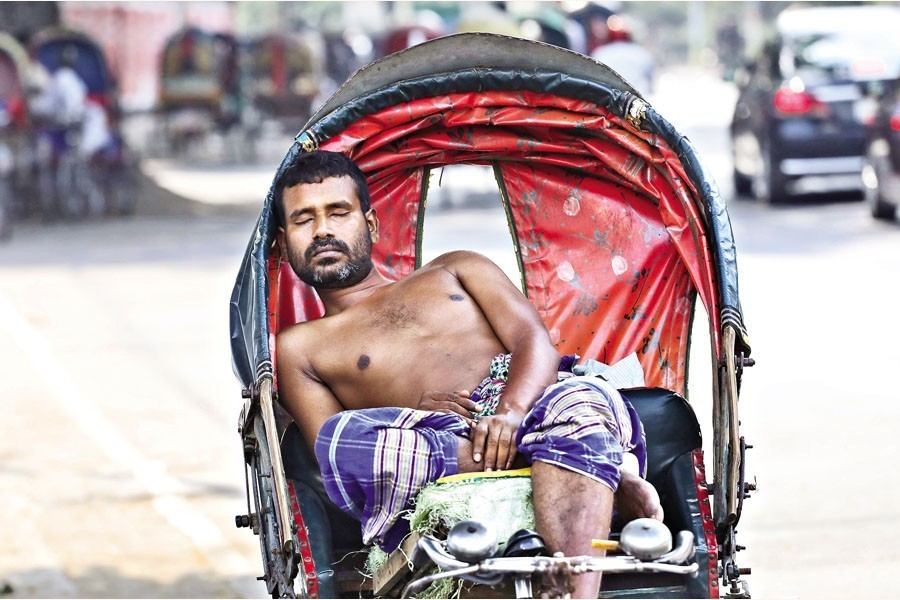Bangladesh has hot, humid weather. Working outdoors can become awfully difficult here during its very long summer season that lasts practically from April to October: that is about 7 months. The midday temperature between June and September often remains above 30 degrees celsius. Humidity also remains high throughout the year and it peaks during the monsoon season (June-October). To make matters worse, climate change is increasing daily average daytime and nighttime temperatures in Bangladesh.
What happens to the workers of Bangladesh who must work outside all day in this blistering heat for a living? Even for those working indoors, for example, in a garment factory, the crowded, loud working environment without appropriate ventilation can become an agonising experience. What happens to the day labourers, street vendors, rickshawalas, brickfields, construction, and transportation workers, traffic police, and all who work and stay in the open air? How do they keep on working for 10-12 hours at a stretch in these hot, humid conditions? What happens to the agricultural workers -- the farmers and fishermen alike -- who toil so hard outside for a living and to feed the nation?
In 2019, employment in the agriculture sector was 27.3 million in Bangladesh according to ILO statistics. The industrial sector is growing in Bangladesh but is still behind the agriculture sector with 14.10 million people working.

Despite agriculture contributing greatly to the overall economy, agriculture workers' health, safety, and well-being at work remain largely unknown. According to the Real Estate & Housing Association of Bangladesh (REHAB) and the Bangladesh Construction Workers Union, 3.5 million people work in the construction industry. One million rickshawpullers are plying the streets of Dhaka city alone for their livelihood. In fact, most jobs in Bangladesh are in the informal sector, where workers do not have almost anything defined: from working space, work hours, formal agreement, or a fixed salary or other benefits. Their access to healthcare is limited to the public system which is often blamed to be of low quality.
According to the US government data, exposure to excessive environmental heat stress has killed about 1000 workers there from 1992-2019 which is an average of 32 fatalities a year. A recent analysis found that the three-year average of heat-related fatalities doubled after 1990 in the USA. Also, an estimated 31,560 work-related heat injuries and illnesses occurred from 2011-2019. However, the actual number of occupational heat-related illnesses, injuries, and fatalities was likely higher because of underreporting. Without any such data on the incidence, risk, and burden of heat-related fatalities, injuries, and illnesses, Bangladeshi workers remain vulnerable to this great occupational risk.
Both outdoor and indoor workers are at risk of hazardous heat exposure in their work settings in Bangladesh and in other similar tropical and sub-tropical countries. Symptoms of heat-related injury and illness can result if the human body is not able to diffuse heat, and the body temperature rises. These may include rashes, cramps, exhaustion, fainting, and muscle breakdown. The existing present health problems including asthma, kidney failure, and heart disease can be exacerbated by extreme heat. Workers may suffer from heat stroke if their body's thermoregulatory capacity is exceeded. Heat-related fatalities occur more frequently in outdoor work environments; however, non-fatal heat-related illness cases also take place in indoor work environments as well. Cooks and restaurant workers, boiler operators, and engine room workers in Bangladesh are at high risk.
Research studies report that recurrent exposure to hazardous heat and resulting dehydration are associated with acute and chronic kidney disease and injury in agricultural workers and others engaged in manual labour in outdoor work settings.
Workers across a lot of industrial sectors and jobs are at risk for hazardous heat exposure and consequential health impacts according to reports in the USA. Hospitalisations due to heat-related causes have been reported more frequently there in postal and delivery services, landscaping, masonry, and commercial building, as well as highway and bridge construction workers.
Agriculture, construction, transportation and warehousing, waste management and remediation services experience the highest rates of heat-related mortality in the USA.
Bangladeshi workers particularly those engaged in the informal sector usually belong to a lower socio-economic stratum and are often emaciated, and physically not strong. While working, they do not find shade and have breaks to take rest from the scorching sunlight; they do not have access to washrooms or clean drinking water; neither they can take an occasional shower or wash their faces or hands. They must stay standing and working for very long hours to produce as much as they can to earn as much as they can to survive, and as often as the only wage-earning members of the family they must support their dependents.
Bangladesh should try to protect its workers -- both indoors and outdoors -- from hazardous heat exposure and must obtain data and evidence on the extent and nature of hazardous heat in the workplaces and the types of interventions and controls that can be made available to prevent heat-related injury and illness. Heat exposure is highly hazardous and must be considered to be a grave public health issue.
Dr. Hasnat M Alamgir is Professor and Chair of Public Health at International University of Business Agriculture and Technology, Dhaka.


